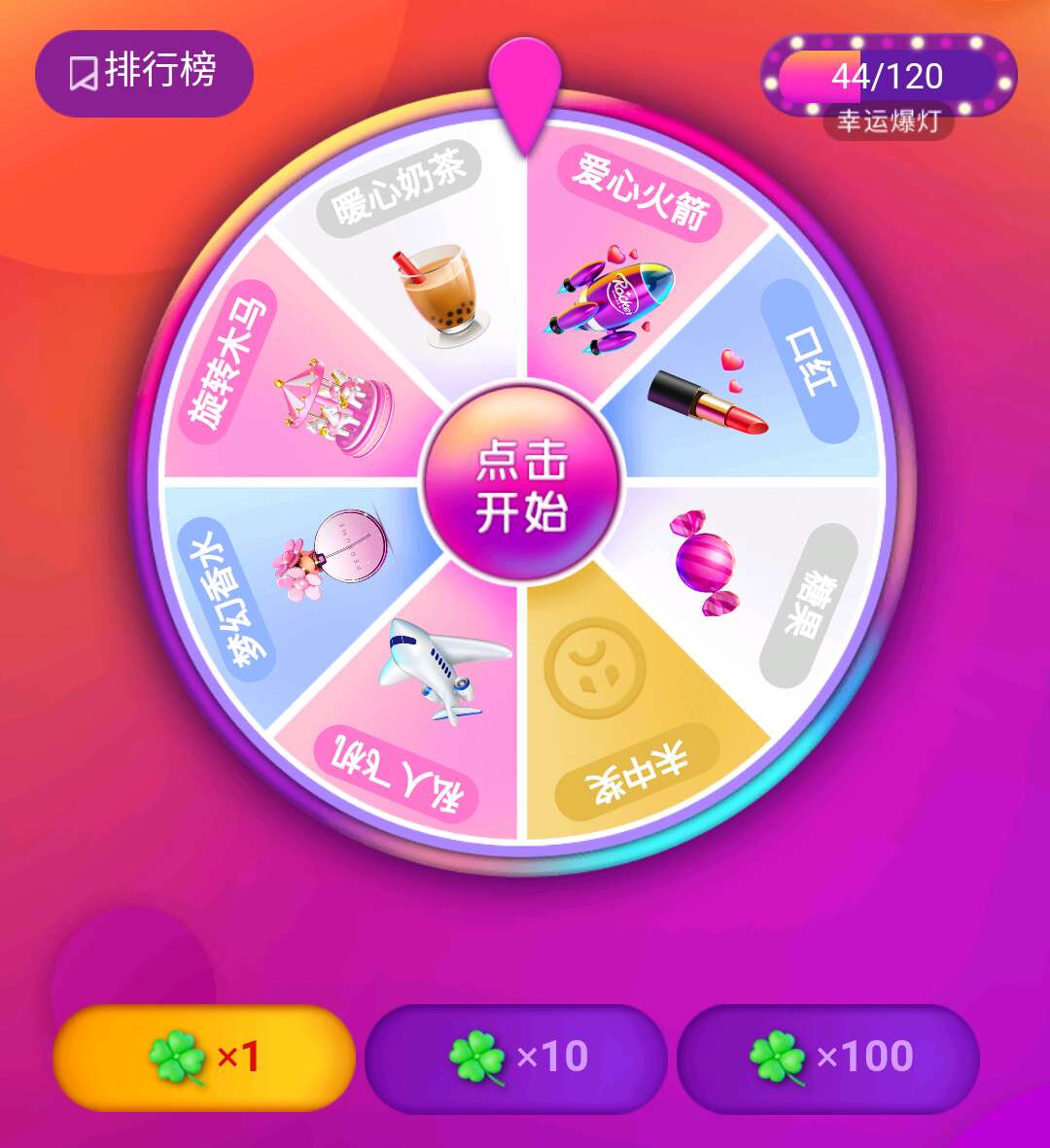在电商促销或一些直播小游戏中,抽奖是一种比较常见的玩法。很多时候,展现给用户的可能是一个大转盘,如下:

通常我们会给出一堆奖品,每个奖品有各自的中奖概率,而且每个奖品可能还有库存的概念,就是说已经被抽完了的奖品是不再参与抽奖的。就拿陌陌里的这个大转盘来举例,奖品列表有爱心火箭、私人飞机、旋转木马、梦幻香水、口红、暖心奶茶、糖果、未中奖(未中奖可以看着是特殊的奖品)等8个奖品,每个奖品会根据其价值有不同的中奖概率,比如中糖果和暖心奶茶的概率高些,但中火箭的概率可能低很多。如果让你用java实现一个抽奖,你会怎么实现它呢?这正是我们今天要探讨的内容。
抽奖算法
在Java中,java.lang.Math.Random()方法本身基本可以保证大量测试的情况下避免高重复,且概率分布比较平均。所以我们根据奖品的概率列表基于java.lang.Math.Random()方法实现一个抽奖的工具类:
- 根据奖品的中奖概率列表probabilityList计算总概率sumRate;
- 根据总概率和各个奖品的概率对概率进行分块,得到分块列表blockList,比如传过来的概率列表是{0.25,0.15,0.6},那么分块区间就是0-0.25,0.25-0.4,0.4-1.0,blockList的集合就是{0.25,0.4,1.0};
- 根据java.lang.Math.Random()平均概率返回0到1之间数字的特性得到nextDouble;
- 把nextDouble的值按大小顺序插入到blockList中;
- 返回nextDouble插入的位置
package cn.lovecto.util;
import java.util.ArrayList;
import java.util.Collections;
import java.util.List;
/**
* 抽奖工具类
*
*/
public class LotteryDrawUtil {
/**
* 根据中奖概率列表进行抽奖,返回被抽中的概率的index
*
* @param probabilityList
* @return
*/
public static int lottery(List<Double> probabilityList) {
if (probabilityList == null || probabilityList.isEmpty()) {
return -1;
}
int lotteryBlockSize = probabilityList.size();
// 计算总概率,这样可以保证不一定总概率是1
double sumRate = 0d;
for (double rate : probabilityList) {
sumRate += rate;
}
// 对应奖品概率分块
List<Double> blockList = new ArrayList<Double>(lotteryBlockSize);
Double tempSumRate = 0d;
// 比如传过来的list是{0.25,0.15,0.6},那么分块区间就是0-0.25,0.25-0.4,0.4-1
for (double rate : probabilityList) {
tempSumRate += rate;
blockList.add(tempSumRate / sumRate);
}
// 根据java的random平均概率返回0到1之间数字的特性
double nextDouble = Math.random();
blockList.add(nextDouble);
// 把数字放到上面的分块区间中,比如nextDouble是0.3,那么就是在第二个分块区间中,则中第二个概率对应的奖品
Collections.sort(blockList);
return blockList.indexOf(nextDouble);
}
}
抽奖逻辑
有了上面的抽奖算法,接下来我们分析下抽奖的逻辑是怎么实现的。为了更贴近使用场景,除了每个奖品有中奖概率外,增加一个库存的概念。因为有时候大奖并不是无限的,可能只有一个。在促销活动进行过程中,运营人员不一定一开始就把大奖的库存放出来,毕竟留在后面才更有悬念,如果大奖一放出来就被抽走了,用户的参与热情估计就没了,因为大家都是冲着大奖来的,就跟买彩票只想中500万一个道理。
定义一个奖品类Award,属性包含奖品名称、中奖概率、库存等。
package cn.lovecto.model;
public class Award {
/**奖品名称*/
private String name;
/**概率*/
private Double probability;
/**库存,为null表示库存无限*/
private Integer inventory = null;
public Award(String name, Double probability, Integer inventory) {
super();
this.name = name;
this.probability = probability;
this.inventory = inventory;
}
public String getName() {
return name;
}
public void setName(String name) {
this.name = name;
}
public Double getProbability() {
return probability;
}
public void setProbability(Double probability) {
this.probability = probability;
}
public Integer getInventory() {
return inventory;
}
public void setInventory(Integer inventory) {
this.inventory = inventory;
}
/***
* 库存是否空了
* @return
*/
public boolean isInventoryEmpty(){
if(this.inventory != null && this.inventory <= 0){
return true;
}
return false;
}
}
接下来,我们模拟一下抽奖逻辑:
package cn.lovecto.util;
import java.util.ArrayList;
import java.util.Iterator;
import java.util.List;
import org.junit.Test;
import cn.lovecto.model.Award;
public class LotteryDrawUtilTest {
@Test
public void lottery() {
// 奖品
List<Award> awards = queryAeardsSortByProbability();
// 中奖的奖品序号
int index = -1;
// 中奖奖品
Award award = null;
// 进行10次抽奖
for (int i = 1; i <= 10; i++) {
// 移除掉库存为空的奖品
removeEmptyInventoryAwards(awards);
// System.out.println(awards.size());
// 抽奖
index = LotteryDrawUtil.lottery(valuesAwardProbability(awards));
award = awards.get(index);
// 扣减库存,此处只是单线程测试,实际环境中还要考虑分布式事务多线程等问题
if (award.getInventory() != null) {
award.setInventory(award.getInventory() - 1);
}
System.out.println(String.format("第%d次抽奖抽中奖品为:%s", i,
award.getName()));
}
}
/**
* 移除掉库存为空的奖品
*
* @param awards
*/
private void removeEmptyInventoryAwards(List<Award> awards) {
Iterator<Award> it = awards.iterator();
while (it.hasNext()) {
Award a = it.next();
if (a.isInventoryEmpty()) {
it.remove();
}
}
}
/**
* 获取奖品概率列表
*
* @param awards
* @return
*/
private List<Double> valuesAwardProbability(List<Award> awards) {
List<Double> values = new ArrayList<Double>();
for (Award a : awards) {
values.add(a.getProbability());
}
return values;
}
/**
* 获取参与抽奖的奖品,返回结果按照中奖概率排序,奖品概率之和尽量等于1
*
* @return
*/
private List<Award> queryAeardsSortByProbability() {
List<Award> awards = new ArrayList<Award>();
// 爱心火箭、私人飞机、旋转木马、梦幻香水、口红、暖心奶茶、糖果、未中奖
awards.add(new Award("爱心火箭", 0.01d, 1));
awards.add(new Award("私人飞机", 0.02d, 1));
awards.add(new Award("旋转木马", 0.03d, 1));
awards.add(new Award("梦幻香水", 0.04d, 1));
awards.add(new Award("口红", 0.10d, 1));
awards.add(new Award("暖心奶茶", 0.10d, 1));
awards.add(new Award("糖果", 0.30d, 1));
// 未中奖库存永远充足
awards.add(new Award("未中奖", 0.40d, null));
return awards;
}
}
运行结果类似:
第1次抽奖抽中奖品为:糖果
第2次抽奖抽中奖品为:口红
第3次抽奖抽中奖品为:爱心火箭
第4次抽奖抽中奖品为:未中奖
第5次抽奖抽中奖品为:未中奖
第6次抽奖抽中奖品为:未中奖
第7次抽奖抽中奖品为:暖心奶茶
第8次抽奖抽中奖品为:未中奖
第9次抽奖抽中奖品为:未中奖
第10次抽奖抽中奖品为:未中奖
抽奖逻辑注意事项
上面的抽奖逻辑只是简单的单线程模拟抽奖算法的有效性,在生产环境中,还需要注意线程安全性、分布式事务等问题,抽奖都是高并发场景下,所以要处理好库存扣减以及库存扣减失败重抽等细节。
 LoveCTO
LoveCTO

